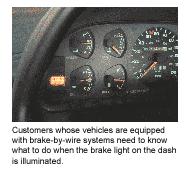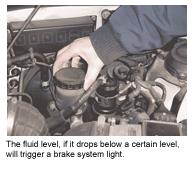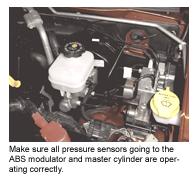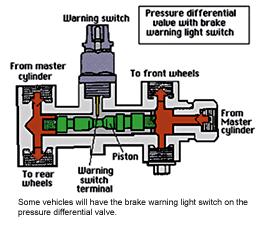Advertisement [ ? ]
Site Links
- Lease Calculator
- Advertise
- My Car ongoing Review
- Members' Chat
- Cars For Sale
- Car Dealers
- Honda "Fit" Manual
- Hyperflex Bushings
- For Sale
- Fix your Car
- Car Manuals
- other manuals - Reference Materials
- DIY Repairs
- Articles
- Video
- Link with Us
- Search Help
- Code your Mac!
- Fly, race, anything R/C
Brake-By-Wire

It seems that everything is wired these days. As technology advances, more and more mechanical systems are being replaced by electronics. With respect to undercar systems, conventional shocks and struts have been replaced with electronic dampers. Coil springs have been replaced with computer-controlled air spring suspensions. Yet most of these changes to date have been limited to high end luxury or performance vehicles. Why? Cost is one reason. The other is reliability.
Electronics can provide significant improvements in many areas of vehicle control, but only if the new systems are trouble-free and dependable - which has not always been the case.
In August 2001, Mercedes sent out a press release touting their forthcoming electronic brake system. It would be the world's first production electronic brake-by-wire system and would be introduced on the Mercedes-Benz SL500. Here's part of what that press release said:
"The company that invented ABS (Anti-Lock Brakes), traction control and ESP (Electronic Stability Control) will launch the world's first production car equipped with an electronic brake system, which provides faster, more sure-footed brake response, especially in emergencies.
"The brake pedal on the 2003 Mercedes-Benz SL500 works with a computer that tells four fast-acting valves exactly how hard to apply the brakes on each wheel. A backup hydraulic master cylinder comes into play only if there's a serious problem or electrical failure.
"With split-second accuracy, the system can change brake pressure on each wheel over uneven surfaces and can even increase brake pressure on just the outside wheels when braking in turns, taking advantage of the higher loading during cornering. Even ABS and ESP work more efficiently since they are more deeply integrated with the brakes instead of functioning as parallel systems.
"A special electrically-driven hydraulic pump and a high-pressure reservoir (or accumulator) provide "always-on" full brake pressure at each wheel. The computer-oriented modulator valves control how much pressure actually operates the brakes at each wheel. In the new system, the bulky vacuum brake booster is now obsolete.
"If the driver switches his foot quickly from accelerator to brake pedal, the electronic brake system recognizes the early signs of an emergency situation and reacts automatically. With the help of the high pressure reservoir, the system raises the pressure in the brake connectors and instantly moves the pads onto the brake disks, which can then spring into action with full force as soon as the brake pedal is depressed. At highway speeds, this pre-loading of the braking system reduces stopping distance by about three percent.

"In addition, the system automatically senses when the road is wet and imperceptibly applies the brakes just enough to keep the disks dry, so that brake operation remains fast and consistent in the rain."
Sounds great, doesn't it? That was then. This is now.
This spring, Mercedes issued a huge recall of 680,000 Mercedes-Benz SL500 and E-Class vehicles equipped with the new "Sensotronic" electronic brake-by-wire system. The recall applies to SL-Class cars built since October 2001, and E-Class cars built since October 2002. It should be noted that only about 140,000 of the recalled vehicles are U.S. models, and that the recall was issued voluntarily by the auto maker as a "precaution" due to a few reported failures of the electronic brake system in unusually high mileage European taxi applications.
Details are sketchy about the cause of the failures. Some say there is a software glitch in the control module while others say the failures have been caused by leaks or bubbles in the high pressure accumulator. Either way, the fault knocks the brake-by-wire system off-line. Fortunately, the backup hydraulic system is still able to stop the vehicle, but without the benefit of power assist.
Mercedes says the fix for the recall takes about an hour and involves reprogramming the control module with new software. But in some cases hardware may also have to be replaced.
The fallout from this recall has put the future of brake-by-wire systems in jeopardy. Mercedes-Benz officials announced that it would not be using the brake-by-wire system in any more new vehicle applications. What's more, they were eliminating up to 600 "needless" electronic features from their vehicles that few people use in an effort to restore their quality and reliability ratings (which have slipped precariously in recent years). The auto maker has been plagued by a string of electronic-related problems that has hurt their ranking compared to other luxury brands.

NO CRYSTAL BALL
So what is the future of brake-by-wire? Bosch, Continental Teves, Delphi, TRW and other OEM supplier companies have all developed next generation brake-by-wire systems for potential use on future vehicles. These companies have invested millions of dollars in research and development of their new systems and would obviously like to find customers for their products. But with the Mercedes recall, other auto makers are taking a long hard look at whether or not this new technology is road-ready and worth the risk.
The new brake-by-wire systems that have been developed to date essentially fall into one of two categories: electro-hydraulic and electro-mechanical.
Electro-hydraulic brake-by-wire systems still use conventional hydraulic brake calipers at each wheel, but pressure is applied by a computer-controlled high pressure pump and actuator solenoids. This is the approach used by Mercedes-Benz with their Bosch-built Sensotronic system. These kinds of brake-by-wire systems use inputs from a brake pedal position sensor (that works much like a throttle position sensor), wheel speed sensors, a steering angle sensor, yaw rate and lateral acceleration sensors to determine the optimum amount of brake pressure to apply at each wheel. The claimed benefits for this type of system are:
- Shorter braking and stopping distances; Optimized pedal feel; No pedal vibration when the system is braking in ABS mode; Eliminates need for a conventional vacuum booster (making it ideally suited for new engines that are "unthrottled" or diesels); and Improved handling and overall driving safety (assuming the system doesn't fail).
With electro-mechanical brake-by-wire systems, there are no hydraulics whatsoever. Braking force is generated at each wheel by a fully electronic caliper. Inside is a small, but powerful electric motor that pushes the pads against the rotor. Many of these systems work best with higher voltages (such as 42 volts) - which means electro-mechanical systems will probably remain on the shelf until auto makers decide whether or not changing to 42 volts is really necessary and worth the cost.
The benefits of electro-mechanical brake-by-wire are essentially the same as electro-hydraulic systems plus it eliminates brake fluid, hoses and lines, the need for a high pressure pump and accumulator, and provides improved braking safety by keeping three brakes operational should one caliper fail.
Being able to precisely control the amount of braking force at each wheel electronically also means a brake-by-wire system can shift more braking effort to the rear brakes during normal braking. This, in turn, can reduce front pad wear while reducing the forward weight shift and nose drive that normally occurs when the brakes are applied.

SAFETY CONCERNS
The last thing any motorist wants is a finicky hi-tech brake system that goes off-line while they are driving in heavy traffic. The brake system must be dependable and have back-up redundancy in case of a failure - otherwise there's no way to stop the vehicle.
Since the late-1960s, all automotive brake systems have been split hydraulically into two separate circuits for safety. Should a caliper, wheel cylinder or hose fail in one circuit, the remaining circuit still has two brakes operational to stop the vehicle.
On most rear-wheel drive vehicles, the front brake circuit is separate from the rear brake circuit. If the front brakes fail, the vehicle still has the rear brakes to bring it to a halt. Plus there's a cable-operated mechanical parking brake ("emergency" brake) as a last resort should both hydraulic brake circuits fail.
On most front-wheel drive cars and minivans, the brake circuits are split diagonally with the left front and right rear brake sharing one circuit, and the right front and left rear brake sharing the other circuit. This is done so one front brake and one rear brake will remain operational if the other pair fail. On FWD vehicles, there is much more forward braking bias because the front wheels are also the drive wheels. Consequently, the rear brakes alone might not be sufficient to bring the vehicle to a halt if the front brakes shared the same circuit and happened to fail.
One of the primary goals of the engineers who are developing the new brake-by-wire systems, therefore, is to make electronic braking as safe and reliable, if not more so than conventional hydraulic braking systems. In this respect, an electro-mechanical system with redundant computer controls and a voltage supply would probably be safer than a conventional brake system.
Why? Because each wheel is on its own separate electrical circuit. If one caliper or circuit fails, it should not affect the other three wheels. This means the vehicle could still have three operational brakes (as opposed to two with today's hydraulic systems) in the event of a brake failure at one wheel.

The biggest gains in safety, though, are made possible when brake-by-wire allows ABS, traction control and stability control to be taken to the next level. As brake control strategies become more and more sophisticated, and use more and more sensor inputs, the brake system can better compensate for driver error and changing road conditions.
Brake-by-wire systems can be easily combined with adaptive cruise control to provide automatic braking if a vehicle ahead suddenly stops and the driver fails to react quickly enough. It can also be combined with some type of crash avoidance system that is capable of detecting objects in the road ahead, or an oncoming vehicle,and apply the brakes before the driver can react.
All this will eventually come to pass. The question is how soon?
MARKET TRENDS
Despite the recent Mercedes-Benz brake recall, many experts still predict brake-by-wire systems will eventually become commonplace once the vehicle manufacturers work out the teething pains of the new technology. As experience and confidence grows, so will the application of brake-by-wire - at least that's what the brake-by-wire OEM suppliers hope.
According to a market forecast published by Tier One in 2001, brake-by-wire installations were predicted to jump from zero in 2002 to over 19% by 2010. The most likely applications were assumed to be luxury vehicles, performance cars and hybrid vehicles (combined with regenerative braking systems). Most experts now say it probably won't take off quite so fast, and the growth curve will depend on further cost reductions, improvements in reliability and when 42 volt electrical systems will go into mass production.
BRAKE ASSIST
A growing number of vehicles today use electronic "brake assist" to decrease braking reaction times and reduce stopping distances in emergency situations. These systems still use a conventional vacuum booster, but add sensors to the brake pedal and/or gas pedal to detect panic braking situations.
When the system detects an abnormally fast application of the brake pedal, it applies full boost pressure to the brakes. This helps to make up for any hesitation the driver may of had in applying the brakes initially, and helps bring the vehicle to a stop much more quickly. Tests have shown that electronic brake assist can reduce average stopping distances in an emergency situation from 10 to 40 percent!
This same type of brake assist can also be provided by mechanical controls at less cost and complexity. A mechanical actuator inside the booster detects the speed at which the driver is applying the brakes. If it "feels" like a panic stop, the booster goes to full boost and slams on the brakes.
Though brake assist is not the same as brake-by-wire, it is a step in the same direction.
ELECTRONIC PARKING BRAKES
The same companies that are developing brake-by-wire systems have also developed electronic parking brake systems to replace cable-operated disc or drum brakes. Instead of pushing a pedal or yanking on a handle to set the parking brake (which few people seem to use anyway), the parking brake can be set by pressing a button. Or, it can be set automatically when the transmission is placed into park.

The advantages of this approach are:
- It can be used to automatically apply the brakes if the primary brake system fails (redundancy backup). It can be used with a "hill start assist" system to prevent a vehicle equipped with a manual transmission and clutch from rolling backwards if the vehicle is stopped or starting out on a hill or incline. It can be combined with an anti-theft system to immobilize the vehicle when it is parked. It eliminates the need for cables and mechanical linkages under the vehicle for cleaner aerodynamics, reduced ground clearance and easier service accessibility.
Our crystal ball can't tell us how soon brake-by-wire will be adopted by other vehicle manufacturers or if the Mercedes-Benz recall will put the brakes on brake-by-wire. But one thing is certain: technology never stands still and brake-by-wire is no exception. It may take awhile, maybe a decade or more. But sooner or later brake-by-wire will become as common as ABS is today.
Adapted from an article written by Larry Carley for Brake & Front End magazine
Back to Brake | Back to Info Main Page
Total messages: 0
